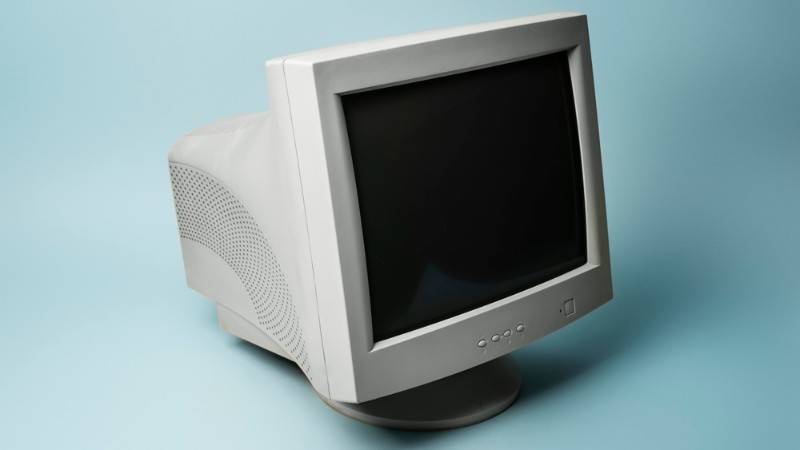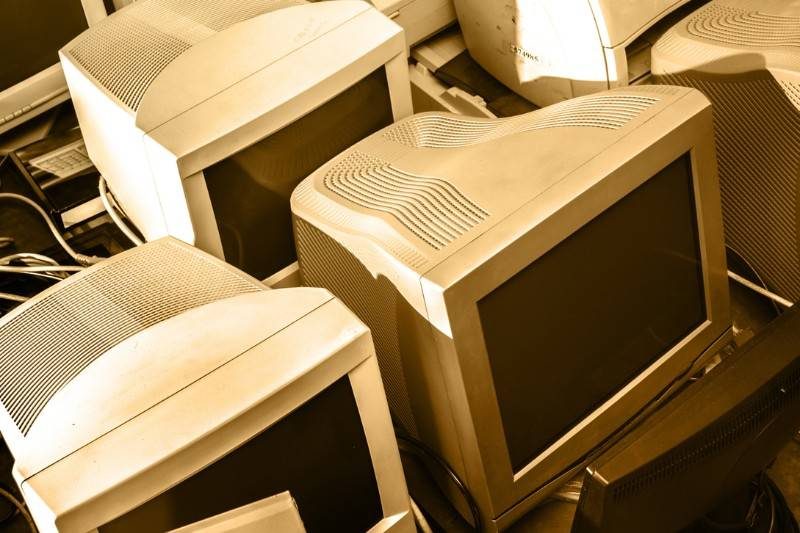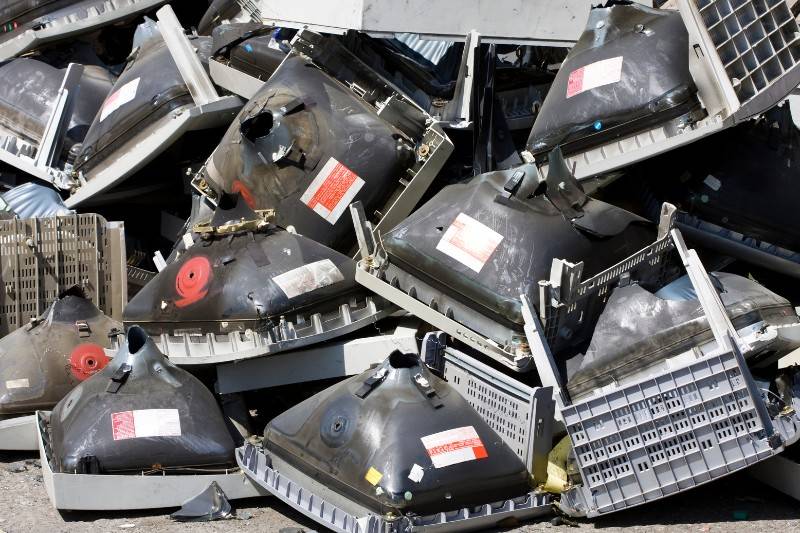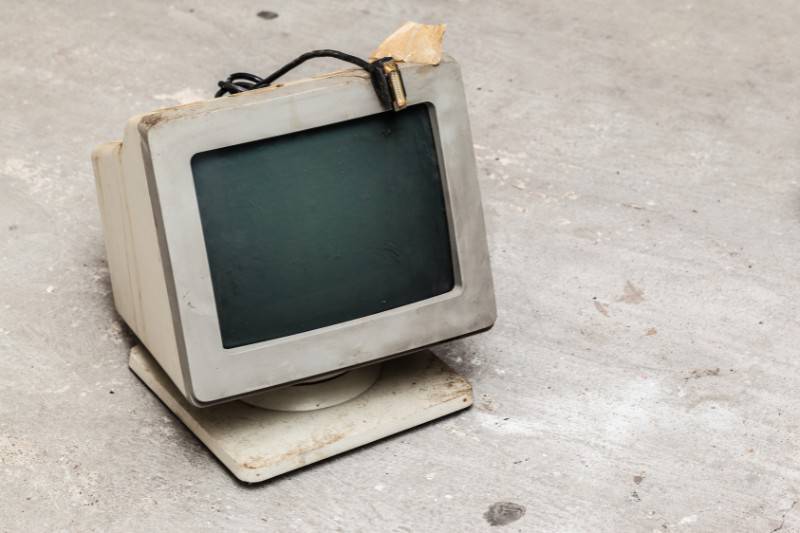Explore the intricate journey of CRT Monitor Recycling, unveiling the treasures within old screens while navigating the hazards, all towards a greener tomorrow.

Remember the bulky CRT monitors before the sleek modern screens took over?
Their recycling is a crucial stride towards responsible e-waste management—these old buddies house hazardous materials, making CRT Disposal a significant concern.
Incorrect disposal is an environmental hazard waiting to happen.
Stepping into Electronic Waste Recycling, especially CRT monitors, is stepping towards a greener planet.
First, I’ll focus on the CRT monitor recycling process.
As we delve deeper, we'll discover how recycling these monitors contributes to reducing electronic waste and paves the way for a sustainable future in e-waste management.
Recycling Process of CRT Monitors and Tube TVs
Diving into the realm of CRT Monitor and Tube TV recycling is like embarking on a journey of restoration. These vintage tech pieces undergo a meticulous process to ensure every reusable part is salvaged and every hazardous element is safely disposed of.
Why not explore the steps involved in CRT monitor recycling?
Step 1: Collection and Transportation
The recycling process begins with consumers or companies bringing their CRT monitors to an electronic recycling drop-off center, like GreenCitizen.
Next, the CRTs are shipped from the collection center to the recycling plant for further processing. Here, the path of transformation begins, setting the stage for a series of organized steps aimed at material recovery and environmental safety.
Unfortunately, many electronic collectors ship CRTs overseas, where they are often dumped. If you choose an electronic recycler with the e-Steward certification, you can be confident that it will be properly recycled in the United States.
Step 2: Disassembly and Sorting
Upon arrival at the recycling facility, the disassembly process commences.
The plastic casing is manually removed, revealing the core components like the panel glass, glass tube, electronic chip boards, wiring, and the electron gun.
The electron gun contains the cathode and anode units. The cathodes are heated filaments that produce a stream of electrons. The positive charge of the anode draws the electrons from the cathode’s copper components and directs the electrons to create the image.
Each part is a treasure trove of materials waiting to be reclaimed.
The disassembly lays bare the different materials, which are then meticulously sorted into separate bins to embark on their individual recycling journeys.
Step 3: Cleaning and Processing
In this phase, the glass tube undergoes a careful dismantling process to prevent implosion due to its vacuum seal.
Inside the glass is a phosphorus coating, which glows when it is hit by light. This phosphorous is removed so the glass can be recycled.
Did you know the glass tube contains about 20% lead by weight?
Adding lead to glass is a common practice to improve optical quality and creates a shield against the radiation produced by the electrons.
After that, the glass undergoes a lead smelting process, ready to be reborn as new CRT monitors.
Step 4: Material Recovery
Here’s where the magic happens!
Once the plastics, electronic gun, glass tube, motherboards, wires, and other miscellaneous parts have been separated, they all undergo a separation process.
This separation process includes steps like crushing, vibrating, shredding, or using a strong water spray to separate the different materials.
The result?
A variety of metals like copper, gold, iron, and steel are separated using strong magnets with specific electronic charges.
These materials, once separated, are off to different processors for further refinement before they are reincarnated into new products. This cycle minimizes the impact of mining and keeps toxins at bay from our beloved environment.
The specialized recycling facilities are the unsung heroes in this narrative.
They ensure each step of the process is executed with precision, adhering to environmental safety norms. Through their efforts, the daunting task of CRT Monitor Recycling morphs into a saga of sustainable practices, contributing to a greener tomorrow.
Valuable Materials Retrieved from Old CRT Monitors
Every CRT monitor holds a mini mine of valuable materials, waiting to be extracted, refined, and repurposed. It’s amazing how what was once a staple of our digital lives now contributes to a sustainable lifestyle.
Here’s what you can find inside a CRT monitor:
Glass
The most prominent material, glass, primarily comes from the screen and tube. The process of CRT glass recycling is meticulous, ensuring the lead within is safely handled. It’s crucial to prevent any lead contamination in CRT Monitors from leaking into the environment.
Plastics
The casing and other parts provide a good amount of recyclable plastic. It’s amazing how this material can be repurposed into numerous products, reducing the demand for new plastic production.
Metals
Ah, the metallic essence of CRT monitors!
Copper, gold, iron, and steel are the main metals that are retrieved. They are like the hidden gems encased within, ready to be extracted and repurposed.
Let’s have a glance at a comparative table showcasing the amount of materials retrieved versus their original composition in a typical CRT monitor:
Material | Amount in CRT Monitor (Before Recycling) | Amount Retrieved (After Recycling) |
|---|---|---|
Glass | 60% | 58% |
Plastics | 25% | 23% |
Copper | 5% | 4.8% |
Gold | 0.01% | 0.01% |
Iron | 5% | 4.8% |
Steel | 4.99% | 4.79% |
Hazardous Materials in CRT Monitors
Now, as we delve deeper into the CRT recycling narrative, let’s focus on the darker side of these vintage gadgets—the hazardous materials lurking within.
It's like every rose has its thorn, right?
CRT Monitors, despite their recyclability, house substances that could be harmful if not handled correctly. Let’s venture into the world of these materials, understanding their nature and the measures taken for safe disposal.
Lead
Ah, the notorious Lead!
It’s found primarily in the glass tube of CRT monitors. While it plays a protective role, its presence is a concern during disposal. Improper handling can lead to lead contamination in CRT Monitors, which is a serious health and environmental hazard.
However, fear not, as the CRT Recycling Process ensures this heavy metal is safely extracted and contained.
Phosphor
Next up is Phosphor, the substance that lights up the screen, creating those vivid images. Though it seems magical, Phosphor must be handled with care during CRT Disposal to prevent harmful exposure.
Barium
Barium, another component, is used to enhance the brightness of the screen. Yet, like its counterparts, it demands cautious handling during disposal to mitigate risks.
Why Should You Recycle CRT Monitors?
Let’s shed light on the big question — why bother recycling CRT Monitors?
Well, my friend, the answer to this is as layered as the CRTs' structure. Recycling these old pals is a journey worth undertaking from the depths of environmental wellness to the peaks of economic sense.
Environmental Impact of CRT Monitor Dumping
Picture this: a vast landfill populated with discarded CRT monitors, silently leaching hazardous substances into the earth.
Grim, isn’t it?
The improper disposal of CRT monitors is a real concern. The lead, phosphor, and barium within can seep into the ground, eventually finding their way into our water sources.
Not a pleasant thought!
Statistics paint a stark picture too.
The amount of global e-waste generated is mind-boggling, with millions of tons dumped annually. And CRT monitors form a substantial chunk of this e-waste mountain. It’s like we’re creating a digital graveyard that haunts our environment.
Now, here comes the knight in shining armor—the laws and regulations.
Countries have recognized the CRT Monitor dumping consequences and are tightening the reins with e-waste recycling laws. These regulations mandate responsible CRT Disposal, ensuring that what could be a ticking environmental time bomb is diffused responsibly.
Benefits of Recycling CRT Monitors
Now, onto the brighter side of the narrative!
Recycling CRT Monitors is like giving them a second lease of life. Let’s recount the goodness that springs from this act:
The cycle of CRT Recycling is similar to a story of redemption.
From being a potential environmental hazard to becoming a resource, the journey of CRT monitors past their prime is a lesson in sustainability.
Final Words
The CRT Recycling Process is a fine example of how electronic recycling facilities meticulously separate and reclaim these materials.
Through environmentally friendly CRT disposal practices, we are not just ensuring safe CRT monitor disposal but also contributing to Material Recovery from CRT.
The journey doesn’t end here!
The reclaimed materials are the heroes that embark on a new journey, ready to be part of new products. This cycle is a testament to how we can substantially impact combating the CRT Monitor Dumping Consequences and championing the cause of E-Waste Recycling Laws.
Recycling old CRT Monitors and Tube TVs is a step towards sustainable living and a leap towards a circular economy.
Every component, whether it's glass or metal, holds the potential to reduce the burden on our planet. So, the next time you come across an old CRT monitor, remember, it’s not just electronic junk, but a resource waiting to be tapped into.












Once i started to go through beginning of post i did not sense that it will be helpful facts for me nevertheless right now I am seriously greatful that I found such place to read. Many thanks to the publisher.
Really you’ve motivated me strongly in my new project by this article.
Everyone loves it when individuals come together and share opinions. Great website, keep it up!
You got a very useful homepage. I have been here reading for about an hour. I’m a newbie and ur knowledge is very useful to me.
This weblog is definitely good, keep posting great information and facts.
Toss the Egg: Fill up a big-sized water balloon until it is nearly as big as a dinosaur egg. Sort a circle and toss this ‘egg’ around in a circle right up until a person drops it. The person who drops it can be asked to sing, dance, mimic or even inform a joke. You can combine this with ” to make it even far more entertaining.
Thank you for your website post. Jones and I are saving to get a new publication on this topic and your post has made us to save our money. Your thinking really resolved all our problems. In fact, in excess of what we had thought of ahead of the time we discovered your excellent blog. I actually no longer have doubts and also a troubled mind because you have clearly attended to all of our needs here. Thanks
The Zune concentrates on being a Portable Media Participant. Not a world wide web browser. Not a sport machine. Possibly in the future it’ll do even greater in individuals areas, but for now it’s a great way to organize and listen to your audio and videos, and is with no peer in that regard. The iPod’s strengths are its internet browsing and apps. If these audio a lot more compelling, probably it is your best choice.
I do concur with you that Seo equipment are not simply available and also we seriously do not know how to suggest them if also these folks are available.I try to be as precise as achievable and it makes really worth it
I am really loving the theme/design of your site. Do you ever run into any browser compatibility issues? A handful of my blog audience have complained about my blog not working correctly in Explorer but looks great in Safari. Do you have any solutions to help fix this issue?
I found about your blog post on google and browse a few of your current early reports. I hope you will help keep up the superior work. I added your current RSS feed for you to my Ask News Site reader. I’m seeing forward to reading a lot more from you down the line!
Really interesting, thanks!
Great post mate.
Thanks for providing this resource! it’s just what I was looking for!
Finally, an issue that I am passionate about. I have looked for information of this caliber for the last several hours. Your site is greatly appreciated.
Completely I share your opinion. In it something is also to me it seems it is excellent idea. I agree with you.
this post is very usefull thx!
Most likely. Most likely.
What good topic
It agree, this remarkable idea is necessary just by the way
Wow this is a great resource.. I’m enjoying it.. good article
Very good phrase
Great work keep it coming, best blog on earth
Absolutely with you it agree. In it something is and it is good idea. I support you.
This is really a really beneficial read for me, Ought to admit that you’re 1 of the most effective bloggers I ever saw.Thanks for posting this informative write-up.
Nice site, nice and easy on the eyes and great content too.
My cousin recommended this blog and she was totally right keep up the fantastic work!
Great work keep it coming, best blog on earth
Thanks for that awesome posting. It saved MUCH time 🙂
GreenCitizen is an environmental conservation company providing you with information, services, and products to help you live a sustainable life.
Follow Us
Join Our Newsletter
Quick Links
Blogs
Services(United States)
For Businesses
For Homes
Useful Links
Copyright © 2024 · All Rights Reserved · GreenCitizen
Privacy Policy | Affiliate Disclosure